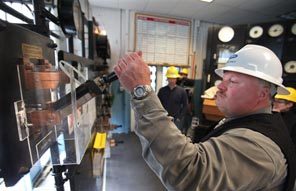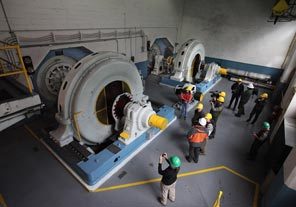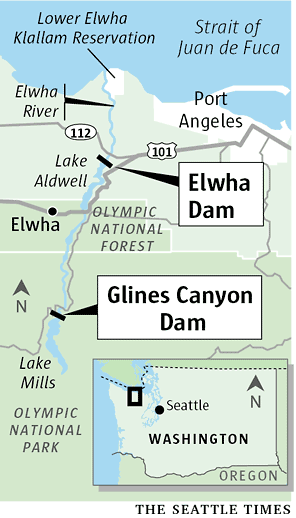Originally published June 1, 2011 at 7:17 AM | Page modified September 21, 2011 at 4:16 PM
Corrected version
Two Elwha River dams unplugged on Wednesday
The end of an era arrived here Wednesday with the final shutdown of two dams on the Elwha River.
Seattle Times staff reporter
STEVE RINGMAN / THE SEATTLE TIMES
Kevin Yancy, manager of the Elwha hydroelectric project for the Bureau of Reclamation, throws a switch Wednesday to shut down the Elwha Dam for good after nearly 100 years of generating electricity. The Elwha and a nearby dam will be torn down beginning this fall.
![]()
PORT ANGELES,
Clallam County —
The end of an era arrived Wednesday with the final shutdown of two dams on the Elwha River.
The dams were unplugged from the Western power grid and their mighty turbines stilled, in preparation for taking both dams down beginning in September.
"We are cutting the heart out of these old girls," said Kevin Yancy, manager of the Elwha hydroelectric project for the U.S. Bureau of Reclamation. But their time, he acknowledged, has passed, after nearly a century of generating power that fueled development of the Olympic Peninsula.
Canadian Thomas Aldwell built Elwha Dam beginning in 1910 in a feat of entrepreneurial daring-do, mustering a crew of hundreds of men in the backcountry to erect the dam in a tight rock canyon five miles from the river's mouth, where the glacial-cold Elwha muscled through, green and fast.
The project was completed in 1913, and Elwha Dam began generating electricity in 1914, powering one of the world's largest sawmills in its day. Beginning in 1920, the dam also powered a pulp mill that still puffs steam at the foot of the Ediz Hook, the signature plume inscribing the sky above Port Angeles now for more than 90 years.
Glines Canyon Dam, 210 feet tall, was begun upriver in 1926 to create more power for the growing mill industry. With its completion in 1927, the dams together helped power the pulp age on the Olympic Peninsula, converting abundant supplies of fresh water and vast stands of hemlock forests into paychecks for generations.
It didn't take long Wednesday, less than half an hour, to kill the power at the upper dam, Glines Canyon. With a mighty bang, Yancy shut down the main generation switch. Then, he walked down a flight of stairs to another floor, where he hand-turned a crank on a gear the size of a manhole cover to shut off the flow of water to a turbine at the dam.
In the handwritten operators' log for the dam, he wrote, "End of an era. Goodbye Glines."
Slowly, the building that for so many years was so loud that earplugs were always required, went quiet.
Walking out the door, Yancy said, "We're dead, that's it. She's done, buddy."
In his truck on the way to Elwha Dam to shut it down, too, Yancy reflected.
"It really is the end of an era. Old plants like these, there is an art to making electricity in these manually run plants, keeping it on. Today, they are all automated and no one is building any more hydropower."
Leading up to the dam's last days, the brass and glass and all of their gauges were polished, the floors swept clean, the paint new and fresh, and the equipment — some nearly 100 years old — was operating perfectly.
"I wanted everything running smoothly," Yancy said.
To him, it was important to keep the dams in good working order.
"I didn't want an apathetic response or a bitterness and 'It's coming out, who cares anyway.' We had a job to do here, and we wanted to do it with dignity and pride."
The dams generated an average of 19 megawatts, enough to power about 15,000 average homes. At full capacity, the dams could crank out as much as 25 megawatts. Their capacity today is replaced by the Bonneville power grid. The two dams once powered a string of peninsula towns and industries as far away as the Bremerton Navy Yard.
That power came at a price: Both dams were built without fish passage, illegal even back then, but finessed with a deal cut with state fisheries officials.
Taking the dams out is part of a more than $325 million restoration plan intended to bring back five runs of salmon to the river. More than three quarters of its watershed is within Olympic National Park, making it one of the best opportunities for restoration in the lower forty-eight.
The plan is for the river to be free-flowing within three years — after nearly 20 years of talking about it. President George H.W. Bush signed the Elwha Restoration Act in 1992. It took all that time to appropriate the money to pay for the takedown and broker the politics of the project.
Meanwhile, the cost ballooned to about three times original projections. Former U.S. Sen. Slade Gorton, the Republican lawmaker who fought appropriating the money for years, won't be celebrating Wednesday.
"It is something with which I disagreed, and I don't wish to be reminded of it," Gorton said last week at his Seattle law office.
But the shutdown is a step some wondered if they would ever witness. Adeline Smith, 93, one of the oldest members of the Lower Elwha Klallam Tribe, said she remembered rescuing baby salmon stranded in pools when operation of the dams would ramp the river levels up and down.
"We felt sorry for them," she said of the gasping smolts.
Robert Elofson, river restoration director for the tribe, watched as the turbines on Elwha Dam slowly wound down, finally going still. "I've got a few tears in my eyes," he said in the sudden quiet. "The tribe always wanted the dams out of the river."
The river-recovery project actually started last fall, when the park service hired contractors to dig a pilot channel in a vast delta of sediment built up behind the upper dam so solidly it grew a thick forest of alder.
Straight as a zipper, the channel was intended to help the river erode some 14 million cubic yards of sediment behind the dams. It's already started: Winter storms and a 6-inch drawdown of the reservoir have helped the river gain gradient and chew at the delta.
Tim Randle, of the Bureau of Reclamation, led a team of scientists inspecting the delta last month, to check on whether the river is getting off on a good start, sluicing the sediment down its channel.
As he hiked the eroding delta, Randle said he was pleased to encounter an already changing landscape.
"River recovery has started."
Slowly, the heat in the powerhouse thrown off by the thrumming machines cooled. The sound of the river replaced the sound of the machine as, no longer diverted through the turbines, it roared full force through the spill gates and barreled out the tailrace.
Kevin Yancy gave a final switch a yank. "Time remaining: 00:00" read the master gauge on the control panel.
"We've done our deed here, put her to bed," Yancy said.
His hands full of plastic grocery sacks after cleaning out his desk, journeyman dam operator Billy Cargo headed out the door for the last time.
An operator's manual, a couple of pairs of old coveralls, a can of spray cheese. That's what he took with him on his way out — that, and a lot of memories.
One of the last manually operated hydroelectric projects in the region, Cargo knew the thrum of the dams' 60-cycle generation, purring along through the night as he worked the graveyard shift solo.
"You can feel that hum, it's soothing," Cargo said. "It was a romantic job, the best job in the world."
He didn't have to be here for the shutdown, wasn't scheduled to work. But he wouldn't have missed it, Cargo said. "It's history. A major piece of history."
Lynda V. Mapes: 206-464-2736
Information in this article, originally published June 1, 2011, was corrected June 1, 2011. A previous version of this story gave an incorrect estimate of the number of homes powered by 19 megawatts. The correct number is about 15,000 average American homes.














